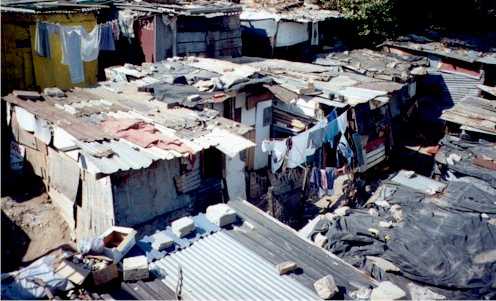
|
|
|
|
|
|
| Sustainable
Communities |
|
Industrial Ecosystems | Municipal Infrastructure | Business Opportunities | Communities and Sustainable Agriculture Integrative Regional Action Planning
The Unsustainability of Cities Patterns of urban development are a particular focus of concern in the search for a path to a sustainable world. The majority of world cities are vortices of unsustainability, concentrating environmental threats and social and economic distress.
 A squatter settlement in a township near Johannesburg. Photo by George Marnewick By 2000 50% of the world's population was in cities and megacities (cities with ten million or more residents). So urban planners, architects, environmentalists, social activists, and many others have focused their quest for sustainability on the transformation of cities and towns. Existing communities have enlisted in a sustainable community movement, forming visions, action strategies, and urban sustainability indicators. Planners and designers have created major new town development projects that feature more advanced ecological design and land-use, including Coffee Creek in Indiana, Haymount in Virginia, and Abacoa in Southern Florida. While their town plans are more compact than suburban tracts, they still use more land than is available for new town developments in most countries. While excellent in terms of ecological design, such projects do not begin to address the economic development and social issues of sustainable development, particularly in developing countries. Sustainable community initiatives in established cities have achieved some successes in waste reduction, pollution prevention, forming of environmental industry economic development strategies, development of eco-industrial parks, and ecological restoration. However such initiatives, after forming bold visions, often suffer from "creeping incrementalism", moving forward in a fragmented, unsystemic fashion. Greatest energy often goes to increasing efficiency of resource use, only one of the many requirements for sustainability. Researchers such as Richard Levine and Ernest Yanarella at University of Kentucky's Center for Sustainable Cities argue that an incremental path alone is unlikely to achieve true sustainability. They fear that some incremental solutions may lock in major errors and generate unforeseen outcomes that further damage social, economic, and environmental systems. (For instance, changing present automobile designs to decrease pollution and increase fuel efficiency ignores the enormous land surface consumed by road transportation. Incremental improvements in autos may actually delay the transition to really sustainable public transportation systems and urban plans.) Levine and Yanarella call for sustainable community designers to shift from piecemeal approaches to whole systems solutions. The issues of urban sustainability are profound for developed and developing countries alike. We believe that a particularly high priority is developing and testing of systems solutions applicable to meeting the massive needs of urban populations in developing countries. Communities seeking to become more sustainable must begin to view their towns and cities — including municipal infrastructures — as living systems with solid economic foundations. Sustainable community planning often does no more than add up the separate interests of stakeholders without ever achieving an integrated view of the community systems embedded in the local and regional environment. An industrial ecology perspective provides tools for understanding the environmental impacts of a community's industry, commerce, infrastructure, and household behavior as a whole system. IE builds common ground for addressing industry's needs in the transition to sustainable communities. The goal is to support business competitiveness and job creation through strategies that also improve environmental protection and quality of life in all dimensions. An industrial ecology perspective brings valuable insights and methods to the process of making our communities more sustainable. A sustainable community is one in which improvement in the quality of human life is achieved in harmony with improving and maintaining the health of ecological systems; and where a healthy economy's industrial base supports the quality of both human and ecological systems. IE offers to sustainable
community planning an awareness of the
community as a living system embedded in its natural systems. It
provides tools for understanding the environmental impacts of a
community's industry, commerce, infrastructure, and household behavior
as a whole system. IE builds common ground for addressing industry's
needs in the transition to sustainable communities.
Industrial Metabolism of Communities
Planners and citizens can gain a foundation for prioritizing decisions from this sort of analysis early in a sustainable community planning process. It enables identification of major points of waste and pollution. It indicates possible public and private cost-savings and opportunities for new business development. The study establishes a baseline for assessing the community's movement toward sustainability along this vital dimension of efficient use of resources.
Industrial metabolism analysis suggests several useful metrics for assessing the sustainability of system:
The industrial ecology based concepts of eco-industrial parks and industrial ecosystems offer communities and industries two approaches to improving the efficiency of materials and energy flows and reducing other environmental impacts. Eco-industrial park projects in North America, Asia, and Europe offer powerful models for sustainable economic development in communities. Indigo's comprehensive eco-industrial park concept can be found here. Industrial ecologists have proposed that businesses learn to function as industrial ecosystems. This concept is very useful to communities seeking to make their industrial sectors sustainable. Indigo associate, Nick Gertler, has offered this definition: "An industrial ecosystem is a community or network of companies and other organizations in a region who chose to interact by exchanging and making use of byproducts and/or energy in a way that provides one or more of the following benefits over traditional, non-linked operations:The town and industrial region of Kalundborg in Denmark is the most celebrated example of an industrial ecosystem. Researchers are discovering other examples, as in the Austrian province of Styria. Local energy, water, solid and liquid waste, and transportation systems are responsible for managing a large share of a community's energy and materials flows. Even with present growing levels of recycling, municipal infrastructure remains highly wasteful in most cities. An industrial ecology approach would seek strategies for using "soft infrastructure" (finance, education, training, tax incentives, and other public programs) to achieve much higher efficiencies in the operation of the physical infrastructure. For instance, the operation and continuing maintenance of landfills are a major community investment. With the best of recycling programs, a heavy waste stream still flows into most fills. An integrated strategy for extending the life of fills would include:
Business Development Opportunities Entering new markets for existing goods and services: By-product trading among companies opens a number of new business niches for reprocessing and information technologies and for service providers. Producers of a wide range of materials processing equipment (for grinding, sifting, sorting, purifying, and packaging), for instance, will find new markets. Intermediary companies altering wastes mechanically or chemically to meet customer specifications will need this equipment as the concept of waste is eliminated. Another business finding new markets will be manufacturers of equipment to channel flows of materials, water, or heat among plants. Marketing emerging technologies, materials, and processes: Full application of industrial ecology will also require new technologies, materials, and processes. Firms in the market niches described in the previous section would also be drawing upon new products. Reprocessing of by-products may require new chemical or mechanical processes. Product disassembly may require advanced robotics. Commercialization of biopolymers will supplant non-renewable sources in many materials applications. Consulting and information system opportunities Supporting the organizational change, technical, and information needs of an IE-based economy: IE will create new demand for the services of management and environmental consulting companies, training firms, print and electronic publishers, information system providers, and educational institutions. Integrating technologies and methods into innovative new systems. A foundation in industrial ecology could enable established larger corporations, entrepreneurs, or joint ventures of smaller companies to seize competitive advantage. The key would be assembling diverse elements into innovative new systems that meet customer needs while dramatically reducing environmental impacts.
Supply and distribution services to sustainable farming The transition to sustainable
agriculture will benefit rural communities and open many new
business niches quite distinct from the traditional petrochemical farming support companies.
Ecologically-based farmers are already showing a much lighter demand
for material inputs but much greater need for education, training,
consulting, telecommunications, and electronic equipment such as that
used for sensing water and nutrients. Ultimately sustainable
communities must be embedded in sustainable regions. Urban planners
must link cities and towns to their surrounding suburbs, rural land,
and wild land. Integrative regional action planning is an approach Indigo is applying, in team with the Mantaray Team. |
|
|
|
|
|
Contact Us
| Copyright © 2006 Indigo Development | Last Updated: Aprilk 2006
|
 Like any living system, a
community consumes material and energy inputs, processes them into
usable forms, and eliminates the wastes from the process. This can be
seen as "metabolism" of industry, commerce, municipal operations, and
households. Understanding the pattern of these energy and material
flows through a community's economy provides a systemic reading of the
present situation for goal and objective setting and development of
indicators for sustainability.
Like any living system, a
community consumes material and energy inputs, processes them into
usable forms, and eliminates the wastes from the process. This can be
seen as "metabolism" of industry, commerce, municipal operations, and
households. Understanding the pattern of these energy and material
flows through a community's economy provides a systemic reading of the
present situation for goal and objective setting and development of
indicators for sustainability.